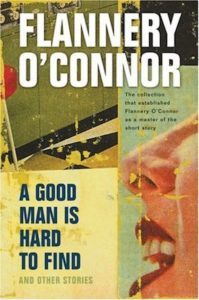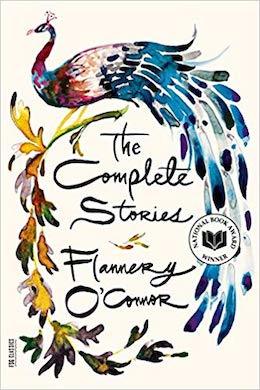Nava Atlas's Blog, page 74
January 22, 2019
Frances Watkins Harper
Frances Ellen Watkins Harper (September 24, 1825 – February 22, 1911) combined her talents as a writer, poet, and public speaker with a deep commitment to abolition and social reform. She sustained a long and prolific publishing career at a time when it was rare for women, particularly women of color, to have a voice. She used her in a multitude of powerful ways, and as a result, she’s been referred to as “the mother of African-American journalism.”
The 1854 collection Poems on Miscellaneous Subjects (1854) was possibly her most successful, having gone through many editions. “The Two Offers” was the first published short story by an African-American woman. And Iola Leroy (1892) was one of the first novels by a black woman to be published.
Born in Baltimore, Maryland, Frances Ellen Watkins was the only child of free African American parents. Orphaned at age three, she was raised by Henrietta and Reverend William Watkins, her maternal aunt and uncle. Under their care, she attended the Academy for Negro Youth, a school run by Reverend Watkins, an active abolitionist. Quite likely, he was an inspiration for Frances’s later work.
At age 14, she went to work as a domestic and seamstress for a Quaker family, in whose home she had access to a wide array of literature.
Abolitionist, poet, essayist, and speaker
Frances launched her writing endeavors in the late 1830s, publishing essays in antislavery journals. Autumn Leaves, her first collection of poems, was published in 1845 when she was just twenty. This foray into print made her one of the first published African-American writers.
A great shift came in 1850 when the Fugitive Slave Act was passed by Congress. The new law made free blacks vulnerable to capture. Frances was compelled to move from Maryland to Ohio for her safety. The following year, she began helping escaping slaves on the Underground Railroad, joining forces with William Still of the Pennsylvania Abolition Society. At the same time, she continued to write regularly for anti-slavery newspapers.
After joining the American Anti-Slavery Society in 1853, Frances embarked on another significant phase of her career as sought-after lecturer. As an effective orator, she spoke out against slavery, the subjugation of women, and other injustices.
A prolific pen
Poems on Miscellaneous Subjects, first published in 1854, would go on to become one of Frances’s most successful titles, going through at least twenty printings. In her writings and speeches, she argued for equality and justice. Her poetry, fiction, essays, and speeches intertwined as a body of work that sought justice and truth.
In 1858, one hundred years before Rosa Parks refused to give up her seat on a bus in Montgomery, Alabama, Frances Watkins refused to give up her seat in the white section of a segregated trolley car in Philadelphia. This incident inspired one of her most enduring poems, “Bury Me in a Free Land,” first published in The Anti-Slavery Bugle.
Among her other literary achievements was the 1859 short story “The Two Offers” (which you can read in full here). Its publication in Anglo-African Magazine, as noted in the introduction to this biography, made it the first short story published by an African-American woman.
In 1860, Frances married a widower named Fenton Harper, a farmer, and briefly retired from public speaking. The couple had one daughter, Mary. When her husband died four years later in 1864, Frances, now using the surname Harper, returned to the lecture circuit. She was left with their daughter and his three children from a previous marriage.
After the Civil War ended in 1865, Frances moved South and worked as a teacher for newly-freed black people. In her encounters with them, she learned firsthand of the hardships they endured during Reconstruction and expressed their stories through poems. These were eventually collected in her book Sketches of Southern Life (1872). She created a fictional ex-slave named Aunt Chloe to serve as a narrator in some of these touching works.
In her lifetime, Harper published 80 poems. “The Slave Mother” is one of her most famous, telling of the heart-wrenching separation of enslaved children from their mothers:
He is not hers, although she bore
For him a mother’s pains;
He is not hers, although her blood
Is coursing through his veins!
He is not hers, for cruel hands
May rudely tear apart
The only wreath of household love
That binds her breaking heart.
Read the rest of “The Slave Mother” and several others in this selection of poems by Frances Watkins Harper.
. . . . . . . . . .

8 Poems by Frances Watkins Harper, 19th Century Author and Reformer
. . . . . . . . . .
Iola Leroy
The well-received novel Iola Leroy, or Shadows Uplifted (1892) was one of the first published full-length novels by an African-American writer. Though it follows the conventional formula for sentimental women’s literature of the late 19th century, Frances wouldn’t have been content with such shallow treatment.
The story also weaves in themes of social justice, temperance, abolition, education, passing, and mixed marriage. Through the character of Iola Leroy, a beautiful young mixed-race woman, Frances Harper illuminates hardships endured during the Civil War Years, including being the target of lecherous sexual predators. Yet in the end, the story becomes an illustration of what was called “racial uplift.”
. . . . . . . . . .
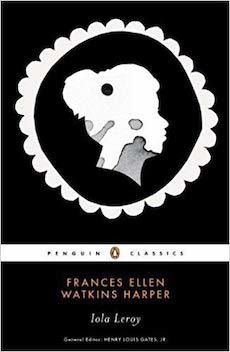
Frances Watkins Harper page on Amazon
. . . . . . . . . .
A long life well lived
Post-Civil War, Harper became more involved with women’s suffrage. Race issues were still her foremost concern, though, as she continued to witness the rise of lynching and the horrendous living conditions of former slaves.
Harper was active in several organizations, not only founding some of them, but holding office. One was the Women’s Christian Temperance Union, on whose behalf she lectured in support of prohibition. She was a co-founder and Vice President of the National Association of Colored Women. She was also a devoted member of the Unitarian Church.
Frances Harper moved to 1006 Bainbridge Street in Philadelphia around 1870 and lived there until her death in 1911. She died of heart failure at the age of 85. She is buried in Eden Cemetery next to her daughter Mary, who had died two in 1909.
In an editorial following her death, W.E.B. DuBois wrote in The Crisis: “It is … for her attempts to forward literature among colored people, that Frances Harper deserves to be remembered … She was, above all, sincere. She took her writing soberly and earnestly; she gave her life to it.”
An excerpt from Harper’s poem “Bury Me in a Free Land” is on a wall of the Smithsonian National Museum of African American History and Culture’s Contemplative Court. It reads: “I ask no monument, proud and high to arrest the gaze of the passers-by; all that my yearning spirit craves is bury me not in a land of slaves.”
In Drumvoices: The Mission of Afro-American Poetry, A Critical History, Eugene B. Redmond wrote: “Up until the Civil War, Mrs. Harper’s favorite themes were slavery, its harshness, and the hypocrisies of America. She is careful to place graphic details where they will get the greatest result, especially when the poems are read aloud … Critics generally agree that Mrs. Harper’s poetry is not original or brilliant. But she is exciting and comes through with powerful flashes of imagery and statement.”
. . . . . . . . . .
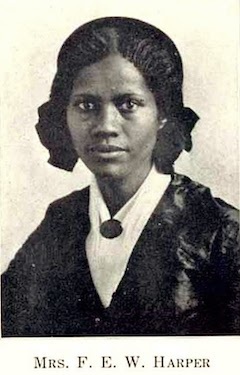
You might also enjoy:
6 Fascinating African-American Women Writers of the 19th Century
More about Frances Watkins Harper on this site
8 Poems by Frances Watkins Harper, 19th Century Author and Reformer
Selected Works
Frances Watkins Harper’s output was vast when taking into account essays, reportage, and speech transcripts. She even wrote three serialized novels that were printed in magazines before the publication of Iola Leroy, the only one of her novels published as a full book. The following selection lists only the works published in book form:
Forest Leaves (1845)
Poems on Miscellaneous Subjects (1854)
The Two Offers (1859)
Moses: A Story of the Nile (1869)
Sketches of Southern Life (1872)
Light Beyond the Darkness, 1890
The Sparrow’s Fall and Other Poems (1894)
The Martyr of Alabama and Other Poems (1894)
Atlanta Offering (1895)
Iola Leroy, or Shadows Uplifted (1892)
Idylls of the Bible (1901)
Biographies
Surprisingly, there has never been a full-scale biography of Frances Watkins Harper, her life and work are referenced in the following books, among them:
Black Women Abolitionists: A Study in Activism, 1828-1860 by Shirley J. Yee, 1992
Outspoken Women: Speeches by American Women Reformers by Judith Anderson, 1984
Black Women in White America: A Documentary History, Gerda Lerner, editor, 1972
Black Women in Nineteenth-Century American Life, Loewenberg and Bogin, editors, 1976
Drumvoices: The Mission of Afro-American Poetry, A Critical History by Eugene B. Redmond, 1976.
More information
Wikipedia
Poetry Foundation
Biography/Your Dictionary
Read and listen online
Listen to Frances E.W. Harper’s works on Librivox
Read Frances Ellen Watkins Harper’s books on Project Gutenberg
. . . . . . . . . .
*This post contains affiliate links. If the product is purchased by linking through, Literary Ladies Guide receives a modest commission, which helps maintain our site and helps it to continue growing!
The post Frances Watkins Harper appeared first on Literary Ladies Guide.
January 18, 2019
8 Poems by Frances Watkins Harper, 19th-Century Author and Reformer
Frances Watkins Harper (1825 – 1911) was an ardent suffragist, social reformer, and abolitionist in addition to her renown as a poet and author.
She wrote prolifically from the time she published her first collection of poetry in 1845, at the age of twenty. A freeborn African-American from Baltimore, Maryland, she was also known as Frances E. W. Harper and by her full name of Frances Ellen Watkins Harper.
The dynamic Frances Harper became involved in anti-slavery societies in the early 1850s and was a conductor on the Underground Railroad.
As she began lecturing on the subjects that she was passionate about, her skills as a compelling public speaker were widely praised. Her 1854 collection Poems on Miscellaneous Subjects was one her most successful publications. Her heartbreaking poem “The Slave Mother” is arguably her best known.
Much later, the novel Iola Leroy, or Shadows Uplifted (1892) was another critical and commercial success.
The eighty poems published during her lifetime along with her fiction and nonfiction works should have earned her a prominent place in American literature. Without a doubt, she deserves to be better known. Here, presenting a taste of her deeply thoughtful and moving work, is a selection of 8 poems by Frances Watkins Harper. Most were written and published in the 1850s and 1860s.
Bury Me in a Free Land
Make me a grave where’er you will,
In a lowly plain, or a lofty hill;
Make it among earth’s humblest graves,
But not in a land where men are slaves.
I could not rest if around my grave
I heard the steps of a trembling slave;
His shadow above my silent tomb
Would make it a place of fearful gloom.
I could not rest if I heard the tread
Of a coffle gang to the shambles led,
And the mother’s shriek of wild despair
Rise like a curse on the trembling air.
I could not sleep if I saw the lash
Drinking her blood at each fearful gash,
And I saw her babes torn from her breast,
Like trembling doves from their parent nest.
I’d shudder and start if I heard the bay
Of bloodhounds seizing their human prey,
And I heard the captive plead in vain
As they bound afresh his galling chain.
If I saw young girls from their mother’s arms
Bartered and sold for their youthful charms,
My eye would flash with a mournful flame,
My death-paled cheek grow red with shame.
I would sleep, dear friends, where bloated might
Can rob no man of his dearest right;
My rest shall be calm in any grave
Where none can call his brother a slave.
I ask no monument, proud and high,
To arrest the gaze of the passers-by;
All that my yearning spirit craves,
Is bury me not in a land of slaves.
The Slave Auction
The sale began—young girls were there,
Defenseless in their wretchedness,
Whose stifled sobs of deep despair
Revealed their anguish and distress.
And mothers stood, with streaming eyes,
And saw their dearest children sold;
Unheeded rose their bitter cries,
While tyrants bartered them for gold.
And woman, with her love and truth—
For these in sable forms may dwell—
Gazed on the husband of her youth,
With anguish none may paint or tell.
And men, whose sole crime was their hue,
The impress of their Maker’s hand,
And frail and shrinking children too,
Were gathered in that mournful band.
Ye who have laid your loved to rest,
And wept above their lifeless clay,
Know not the anguish of that breast,
Whose loved are rudely torn away.
Ye may not know how desolate
Are bosoms rudely forced to part,
And how a dull and heavy weight
Will press the life-drops from the heart.
. . . . . . . . . .

You might also enjoy:
6 Fascinating African-American Women Writers of the 19th Century
. . . . . . . . . .
Going East
She came from the East a fair, young bride,
With a light and a bounding heart,
To find in the distant West a home
With her husband to make a start.
He builded his cabin far away,
Where the prairie flower bloomed wild;
Her love made lighter all his toil,
And joy and hope around him smiled.
She plied her hands to life’s homely tasks,
And helped to build his fortunes up;
While joy and grief, like bitter and sweet,
Were mingled and mixed in her cup.
He sowed in his fields of golden grain,
All the strength of his manly prime;
Nor music of birds, nor brooks, nor bees,
Was as sweet as the dollar’s chime.
She toiled and waited through weary years
For the fortune that came at length;
But toil and care and hope deferred,
Had stolen and wasted her strength.
The cabin changed to a stately home,
Rich carpets were hushing her tread;
But light was fading from her eye,
And the bloom from her cheek had fled.
Slower and heavier grew her step,
While his gold and his gains increased;
But his proud domain had not the charm
Of her humble home in the East.
Within her eye was a restless light,
And a yearning that never ceased,
A longing to see the dear old home
She had left in the distant East.
A longing to clasp her mother’s hand,
And nestle close to her heart,
And to feel the heavy cares of life
Like the sun-kissed shadows depart.
Her husband was adding field to field,
And new wealth to his golden store;
And little thought the shadow of death
Was entering in at his door.
He had no line to sound the depths
Of her tears repressed and unshed;
Nor dreamed ‘mid plenty a human heart
Could be starving, but not for bread.
The hungry heart was stilled at last;
Its restless, baffled yearning ceased.
A lonely man sat by the bier
Of a corpse that was going East.
Lines to a Friend
ON REMOVING FROM HER NATIVE VILLAGE.
The golden rays of sunset fall on a snow-clad hill,
As standing by my window I gaze there long and still.
I see a roof and a chimney, and some tall elms standing near,
While the winds that sway their branches bring voices to my ear.
They tell of a darkened hearth-stone, that once shone bright and gay,
And of old familiar faces that have sadly passed away;
How a stranger on the threshold with careless aspect stands,
And gazes on the acres that have passed into his hands.
I shudder, as these voices, so fraught with mournful woe,
Steal on my spirit’s hearing, in cadence sad and low,
And think I will not hear them–but, ah! who can control
The gloomy thoughts that enter and brood upon the soul?
So, turning from my window, while darkness deepens round,
And the wailing winds sweep onward with yet more piteous sound,
I feel within my bosom far wilder whirlwinds start,
And sweep the cloudy heaven that bends above my heart.
I have no power to quell them; so let them rage and roar,
The sooner will their raging and fury all be o’er;
I’ve seen Atlantic’s billows ‘neath tempests fiercely swell,
But O, the calm succeeding, I have no words to tell!
I think of you, and wonder if you are happy now;
Floats there no shade of sorrow at times across your brow?
When daily tasks are ended, and thought is free to roam,
Doth it not bear you swiftly back to that dear old home?
And then, with wizard fingers, doth Memory open fast
A thrilling panorama of all the changeful past!
Where blending light and shadow skip airy o’er the scene,
Painting in vivid contrast what is and what has been.
And say, does not your mother remember yet with tears
The spot where calm and peaceful have lapsed so many years?
O, would some kindly spirit might give us all to know
How much a tender parent will for a child forego!
We prized your worth while with us; but now you’re gone from sight,
We feel ‘how blessings brighten while they are taking flight.’
O, don’t forget the homestead upon the pleasant hill;
Nor yet the love-lit home you have in all our memories still!
Come, often come to visit the haunts your childhood knew!
We pledge you earnest welcome, unbought, unfeigned and true.
And when before your vision new hopes and pleasure rise,
Turn sometimes with a sunny thought toward your native skies!
My Mother’s Kiss
My mother’s kiss, my mother’s kiss,
I feel its impress now;
As in the bright and happy days
She pressed it on my brow.
You say it is a fancied thing
Within my memory fraught;
To me it has a sacred place —
The treasure house of thought.
Again, I feel her fingers glide
Amid my clustering hair;
I see the love-light in her eyes,
When all my life was fair.
Again, I hear her gentle voice
In warning or in love.
How precious was the faith that taught
My soul of things above.
The music of her voice is stilled,
Her lips are paled in death.
As precious pearls I’ll clasp her words
Until my latest breath.
The world has scattered round my path
Honor and wealth and fame;
But naught so precious as the thoughts
That gather round her name.
And friends have placed upon my brow
The laurels of renown;
But she first taught me how to wear
My manhood as a crown.
My hair is silvered o’er with age,
I’m longing to depart;
To clasp again my mother’s hand,
And be a child at heart.
To roam with her the glory-land
Where saints and angels greet;
To cast our crowns with songs of love
At our Redeemer’s feet.
. . . . . . . . . .

Read books by Frances Watkins Harper online
Frances Watkins Harper page on Amazon
. . . . . . . . . .
The Reunion
Well, one morning real early
I was going down the street,
And I heard a stranger asking
For Missis Chloe Fleet.
There was something in his voice
That made me feel quite shaky.
And when I looked right in his face,
Who should it be but Jakey!
I grasped him tight, and took him home –
What gladness filled my cup!
And I laughed, and just rolled over,
And laughed, and just give up.
‘Where have you been? O Jakey, dear!
Why didn’t you come before?
Oh! when you children went away
My heart was awful sore.’
‘Why, mammy, I’ve been on your hunt
Since ever I’ve been free,
And I have heard from brother Ben, –
He’s down in Tennessee.
‘He wrote me that he had a wife,’
‘And children?’ ‘Yes, he’s three.’
‘You married, too?’ ‘Oh, no, indeed,
I thought I’d first get free.’
‘Then, Jakey, you will stay with me,
And comfort my poor heart;
Old Mistus got no power now
To tear us both apart.
‘I’m richer now than Mistus,
Because I have got my son;
And Mister Thomas he is dead,
And she’s nary one.
‘You must write to brother Benny
That he must come this fall,
And we’ll make the cabin bigger,
And that will hold us all.
‘Tell him I want to see ’em all
Before my life do cease:
And then, like good old Simeon,
I hope to die in peace.’
Dark-Browed Martha
When the frost-king clothed the forests
In a flood of gorgeous dyes,
Death called little dark-browed Martha
To her mansion in the skies.
‘Twas a calm October Sabbath
When the bell with solemn sound
Knelled her to her quiet slumbers
Low down in the darksome ground.
Far away, where sun and summer
Reign in glory all the year,
Was the land she left behind her,
To her simple heart so dear.
There a mother and a brother,
Meeting oft at close of day,
Spoke in tender, tearful whispers
Of the loved one far away.
‘I am thinking,’ said the mother,
‘How much Martha’ll get to know,
And how smart and bright ’twill make her,
Travellin’ round the country so.
‘Spect she’ll be a mighty lady,
Shinin’ jewels in her ears;
But I hope she won’t forget us,–
Dat is what dis poor heart fears.’
”Deed she won’t,’ then spoke the brother,
‘Martha’ll love us just as well
As before she parted from us, —
Trust me, mammy, I can tell.’
Then he passed a hand in silence
O’er his damp and swarthy brow,
Brushed a tear from off the eyelid,—
‘O that she were with us now!’
‘Pshaw! don’t cry, Lem,’ said the mother,
‘There’s no need of that at all;
Massa said he’d bring her to us
When the nuts began to fall.
The pecans will soon be rattling
From the tall plantation trees,
She’ll be here to help us pick them,
Brisk and merry as you please.’
Thus they talked, while she they waited
From the earth had passed away;
Walked no more in pleasant places,
Saw no more the light of day;
Knew no more of toilsome labor,
Spiteful threats or angry blows;
For the Heavenly One had called her
Early from a life of woes.
Folded we the tiny fingers
On the cold, unmoving breast;
Robed her in a decent garment,
For her long and dreamless rest;
And when o’er the tranquil Sabbath
Evening’s rays began to fall,
Followed her with heavy footsteps
To the home that waits us all.
As we paused beside the churchyard,
Where the tall green maples rise,
Strangers came and viewed the sleeper,
With sad wonder in their eyes;
While my thoughts flew to that mother,
And that brother far away:
How they’d weep and wail, if conscious
This was Martha’s burial day!
When the coffin had been lowered
Carefully into the ground,
And the heavy sods fell on it
With a cold and hollow sound,
Thought I, as we hastened homewards,
By the day’s expiring light,
Martha never slept so sweetly
As she’ll sleep this Sabbath night.
The Night of Death
Twas a night of dreadful horror, —
Death was sweeping through the land;
And the wings of dark destruction
Were outstretched from strand to strand
Strong men’s hearts grew faint with terror,
As the tempest and the waves
Wrecked their homes and swept them downward,
Suddenly to yawning graves.
‘Mid the wastes of ruined households,
And the tempest’s wild alarms,
Stood a terror-stricken mother
With a child within her arms.
Other children huddled ’round her,
Each one nestling in her heart;
Swift in thought and swift in action,
She at least from one must part.
Then she said unto her daughter,
“Strive to save one child from death.”
“Which one?” said the anxious daughter,
As she stood with bated breath.
Oh! the anguish of that mother;
What despair was in her eye!
All her little ones were precious;
Which one should she leave to die?
Then outspake the brother Bennie:
“I will take the little one.”
“No,” exclaimed the anxious mother;
“No, my child, it can’t be done.”
“See! my boy, the waves are rising,
Save yourself and leave the child!”
“I will trust in Christ,” he answered;
Grasped the little one and smiled.
Through the roar of wind and waters
Ever and anon she cried;
But throughout the night of terror
Never Bennie’s voice replied.
But above the waves’ wild surging
He had found a safe retreat,
As if God had sent an angel,
Just to guide his wandering feet.
When the storm had spent its fury,
And the sea gave up its dead
She was mourning for her loved ones,
Lost amid that night of dread.
While her head was bowed in anguish,
On her ear there fell a voice,
Bringing surcease to her sorrow,
Bidding all her heart rejoice.
“Didn’t I tell you true?” said Bennie,
And his eyes were full of light,
“When I told you God would help me
Through the dark and dreadful night?”
And he placed the little darling
Safe within his mother’s arms,
Feeling Christ had been his guardian,
‘Mid the dangers and alarms.
Oh! for faith so firm and precious,
In the darkest, saddest night,
Till life’s gloom-encircled shadows
Fade in everlasting light.
And upon the mount of vision
We our loved and lost shall greet,
With earth’s wildest storms behind us,
And its cares beneath our feet.
. . . . . . . . .
*This post contains affiliate links. If the product is purchased by linking through, Literary Ladies Guide receives a modest commission, which helps maintain our site and helps it to continue growing!
The post 8 Poems by Frances Watkins Harper, 19th-Century Author and Reformer appeared first on Literary Ladies Guide.
January 13, 2019
Somber and Beautiful Quotes from Ethan Frome by Edith Wharton
Ethan Frome (1911) by Edith Wharton is a somber tale indeed, but so beautifully told that many readers return to it again and again. An original review in the San Francisco Call from the year the book was published sketches the outline of the novella:
“Twenty years before the tale opens we learn that Ethan Frome has been crippled in a terrible accident … Ethan had his old parents to take care of and after their death he married the young woman who had helped him to nurse them … In a few years she needed assistance, so a young poor relation, Mattie Silver, came to live with them. Slowly she and Ethan fell in love. What happens next isn’t ‘happily ever after.’”
Read the rest of the review as well as Edith Wharton’s own introduction to the story. To get a sense of the gorgeous yet spare language, here’s a selection of quotes from Ethan Frome, one of Edith Wharton’s most enduring works.
. . . . . . . . .
“That man touch a hundred? He looks as if he was dead and in hell now!”
. . . . . . . . .
“He seemed a part of the mute melancholy landscape, an incarnation of its frozen woe, with all that was warm and sentient in him fast bound below the surface; but there was nothing nothing unfriendly in his silence.”
. . . . . . . . .
“There was in him a slumbering spark of sociability which the long Starkfield winters had not yet extinguished. By nature grave and inarticulate, he admired recklessness and gaiety in others and was warmed to the marrow by friendly human intercourse.”
. . . . . . . . .
“He was a poor man, the husband of a sickly woman, whom his desertion would leave alone and destitute; and even if he had had the heart to desert her he could have done so only by deceiving two kindly people who had pitied him.”
. . . . . . . . .
“After the funeral, when he saw her preparing to go away, he was seized with an unreasoning dread of being left alone on the farm; and before he knew what he was doing he had asked her to stay there with him. He had often thought since that it would not have happened if his mother had died in spring instead of winter…” (Ethan musing on how he got caught up with Zeena, a woman he didn’t love)
. . . . . . . . .
“She had an eye to see and an ear to hear: he could show her things and tell her things, and taste the bliss of feeling.”
. . . . . . . . .
“They seemed to come suddenly upon happiness as if they had surprised a butterfly in the winter woods.”
. . . . . . . . .
“Ethan’s love of nature did not take the form of a taste for agriculture.”
. . . . . . . . .
“It pleased Ethan to have surprised a pair of lovers on the spot where he and Mattie had stood with such a thirst for each other in their hearts; but he felt a pang at the thought that these two need not hide their happiness.”
. . . . . . . . .
“I want to put my hand out and touch you. I want to do for you and care for you. I want to be there when you’re sick and when you’re lonesome.”
. . . . . . . . .
“If she’d ha’ died, Ethan might ha’ lived; and the way they are now, I don’t see’s there’s much difference between the Fromes up at the farm and the Fromes down in the graveyard; ‘cept that down there they’re all quiet, and the women have got to hold their tongues.”
. . . . . . . . . .
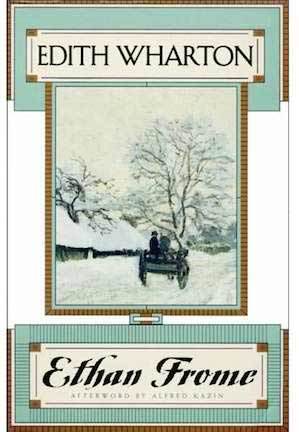
Ethan Frome by Edith Wharton on Amazon
. . . . . . . . . .
“Against the dark background of the kitchen she [Zeena] stood up tall and angular, one hand drawing a quilted counterpane to her flat breast, while the other held a lamp. The light, on a level with her chin, drew out of the darkness her puckered throat and the projecting wrist of the hand that clutched the quilt, and deepened fantastically the hollows and prominences of her high-boned face under its rings of crimping-pins.
To Ethan, still in the rosy haze of his hour with Mattie, the sight came with the intense precision of the last dream before waking. He felt as if he had never before known what his wife looked like.”
. . . . . . . . .
“The sudden heat of his tone made her color mount again, not with a rush, but gradually, delicately, like the reflection of a thought stealing slowly across her heart.”
. . . . . . . . .
“It was a long time since any one had spoken to him as kindly as Mrs Hale. Most people were either indifferent to his troubles, or disposed to think it natural that a young fellow of his age should have carried without repining the burden of three crippled lives. But Mrs Hale had said ‘You’ve had an awful mean time, Ethan Frome,’ and he felt less alone with his misery.”
. . . . . . . . .
“Ethan looked at her with loathing. She was no longer the listless creature who had lived at his side in a state of sullen self-absorption, but a mysterious alien presence, an evil energy secreted from the long years of silent brooding.”
. . . . . . . . .
“They had never before avowed their inclination so openly, and Ethan, for a moment, had the illusion that he was a free man, wooing the girl he meant to marry. He looked at her hair and longed to touch it again, and to tell her that is smelt of the woods; but he had never learned to say such things.”
. . . . . . . . .
“The inexorable facts closed in on him like prison-warders handcuffing a convict. There was no way out – none. He was a prisoner for life, and now his one ray of light was to be extinguished.”
. . . . . . . . .

See also: Perceptive Quotes by Edith Wharton
. . . . . . . . .
“They stood together in the gloom of the spruces, an empty world glimmering about them wide and gray under the stars.”
. . . . . . . . .
“The return to reality was as painful as the return to consciousness after taking an anesthetic.”
. . . . . . . . .
“She had taken everything else from him, and now she meant to take the one thing that made up for it all.”
. . . . . . . . .
More about Ethan Frome by Edith Wharton
Wikipedia
Reader discussion of Ethan Frome on Goodreads
Listen to Ethan Frome on Librivox
Film adaptation of Ethan Frome
. . . . . . . . .
*This post contains affiliate links. If the product is purchased by linking through, Literary Ladies Guide receives a modest commission, which helps maintain our site and helps it to continue growing!
The post Somber and Beautiful Quotes from Ethan Frome by Edith Wharton appeared first on Literary Ladies Guide.
January 10, 2019
In Search of Nellie Bly: Uncovering America’s Pioneering Investigative Journalist
Excerpted from Nellie Bly: Daredevil, Reporter, Feminist by Brooke Kroeger, the most comprehensive biography to date on the pioneering investigative journalist, born Elizabeth Jane Cochran (she later spelled her name Cochrane) on May 5, 1864, in Cochran’s Mills, Pennsylvania:
Nellie Bly was one of the most rousing characters in the late nineteenth and early twentieth centuries. In the 1880s she pioneered the development of “detective” or “stunt” journalism the acknowledged forerunner of full-scale investigative reporting.
While she was still in her early twenties, the example of her fearless success helped open the profession to coming generations of women journalists clamoring to write hard news.
Accomplished the extraordinary as a matter of course
Bly performed feats for the record books. She feigned insanity and engineered her own commitment to a mental asylum, then exposed its horrid conditions. She circle the globe faster than any living or fictional soul. She designed, manufactured, and marketed the first successful steel barrel produced in the United States. She owned and operated factories as a model of social welfare for her 1,500 employees.
She journeyed to Paris to argue the case of a defeated nation. She wrote a widely read advice column while devoting herself to the plight of the unfortunate, most notably unwed and indigent mothers and their offspring.
Bly’s life — 1864 to 1922 — spanned Reconstruction, the Victorian and Progressive eras, the Great War and its aftermath. She grew up without privilege for higher education, knowing that her greatest asset was the force of her own will. Bly executed the extraordinary as a matter of routine …
. . . . . . . . . .
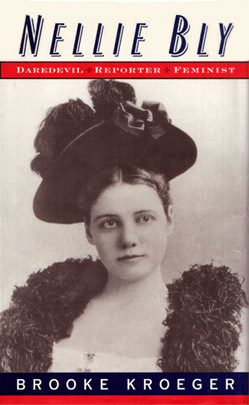
Nellie Bly: Daredevil, Reporter, Feminist by Brooke Kroeger
. . . . . . . . . .
An indomitable will, an incredible life story
To admirers, she was Will Indomitable, The Best Reporter in America, the Personification of Pluck. Amazing was the adjective that always came to mind. As the most famous woman journalist of her day, as an early woman industrialist, as a humanitarian, even as a beleaguered litigant, Bly kept the same formula for success: Determine Right. Decide Fast. Apply Energy. Act with Conviction. Fight to the Finish. Accept the Consequences. Move on.
It is baffling that a life of such purpose and accomplishment — still daunting, even by the contemporary standard —did not incite the passions of any number of serious authors over the years.
Even if none of the more commercially successful biographers sensed the essential universality of Bly’s dramatic story, at least it should have snared the narrative the imagination of a feminist scholar or two, a doctoral candidate perhaps.
An affecting and inspiring nonfiction heroine
And yet, the Library of Congress catalog is without one documented biography of Nellie Bly … more disturbing is the puny place she occupies insured was in histories, which dismissed her with this sentence, maybe a paragraph.
Biographical sketches still appear in academic works and in the literary and women’s biographical dictionaries however. And Bly’s exemplary story has inspired over the past half-century at least a score of juvenile books. As a girl of ten, I happen to read one of them. Bly’s story had a greater impact on my life than that of any other nonfiction heroine.
I hadn’t thought about Bly in years, but when my daughter, Brett, turned ten in 1986, I wanted to introduce her to the real-life character who had affected me so deeply. We had moved to New York two years before, and I thought a book length encounter with Mother’s patron saint would help her make sense of the hopscotch childhood she had been subjected to between the ages of three weeks and eight years.
In that time, Brett had lived in Brussels, London, Tel Aviv (with weekends in the Gaza Strip), and London again. It’s suddenly became very important to locate that book and share with her.
. . . . . . . . . .
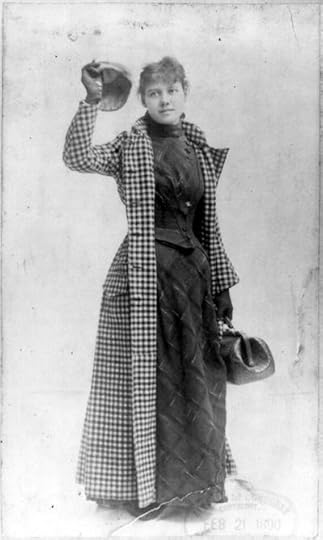
Bly gained worldwide fame for her 1889 “Around the World in 72 Days” journey;
she outdid the fictional version in Around the World in Eighty Days by Jules Verne
. . . . . . . . . .
Relegated to virtual obscurity
That is when I first became conscious of Bly’s near invisibility. Judging from what was available in the bookstores, nothing has come along to replace those early biographies. From the reference librarians at the Library of Congress, I learned of the two Bly biographies that had been published in the 1950s in addition to the one I had read as a child, and that numerous others had come out sense.
Through a search firm, I obtained a 1971 reprint of Mignon Rittenhouse’s The Amazing Nellie Bly and Jason Marks’s The Story of Nellie Bly. In the main branch of the public library in Kansas City, I found the other two from the 1950s, Iris Noble’s incorrectly titled Nellie Bly: First Woman Reporter and Nina Brown Baker’s Nellie Bly. I also found two fairly extensive juvenile biographies written as recently as 1989: Making Headlines: A Biography of Nellie Bly by Kathy Lynn Emerson and Nellie Bly by Elizabeth Ehrlich.
Brent and I read the books. She grew interested enough to turn Bly into a research project for school a few years later. We found that though all these books covered much the same ground, none of them agreed on any of the most basic facts of Bly’s life, right down to the dates, ages, and spellings of important names, including hers.
None seem to have been based on much primary material. I began to think that there wasn’t much primary material. Brett thought I should find out …
. . . . . . . .

. . . . . . . .
Poor planning for posterity
Bly’s error seems to have been leaving behind a substantial written record to which there would be ready access. Given the circumstances at the end of her life this was probably not by design. But the fact is, no diaries or journals of hers has surfaced. When I begin this project, there were only seven letters of hers — six at the Carnegie Library in Pittsburgh and one in the Sofia Smith collection at Smith College. The only family memorabilia, assembled by her grandnephew James Agey, disappeared after his death in 1981.
The results of this situation has been that when ever the noon details of Bly’s life have been summoned for those passing references in journalism histories or for sketchy biographical profiles, they have always derived from the same anorexic body of sources …
The problem with Bly’s legacy, then, was poor planning for posterity. Guaranteeing a place in history, it seems, takes more than living a phenomenal life. In most cases, it takes careful attention to creating a documented record of that life that isn’t too hard to retrieve.
Retrieving a life
It began to make sense why the life of Nellie Bly had been relegated to the fascination of little girls — and fear and fewer of them as time passed, with limited circulation of those juvenile books. Bly’s was an amazing story, but as a subject of serious inquiry, simply not cost-effective. Scholarship, then was not going to be the impetus for her historical rescue.
Alternative motivation was required: a quirky, even maniacal devotion to her memory, perhaps; and an intuitive believe that, in the end, she would have turned out to have been worth the bother.
By tracing Bly’s Life trail backward through the layers of accepted lore and faulty secondary information, drilling for the closest primary source, I attempted to eliminate all the confusing factoids about her. Most of these have emerged from incorrect information in books, and newspaper and magazine articles over the years, which had gained credence through repetition.
Some came from sections the early biographers supplied to fill in gaps. Census records helped clarify dates and family circumstances, as did old county and family histories, however flawed. I found enlightening paragraphs about Bly in the memoirs of some of her colleagues and in biographies of them.
Combing through all of those old newspapers on microfilm, page by page by page, I have compiled as complete a record as possible of Nellie Bly, Working Reporter, and have copies of all of those stories.
. . . . . . . .
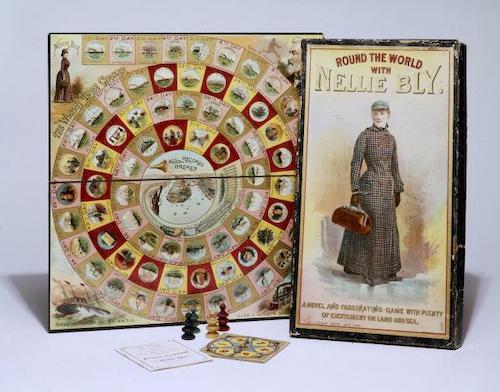
A board game inspired by Bly’s around-the-world journey came out in 1890
. . . . . . . . .
Clearing up myths
Several hunches paid off: For example, I located Bly’s baptismal record, which put the confusion Bly herself caused on the question of her birth date to permanent rest. Thankfully, she was highly litigious. There was court testimony of hers on record from the time she was fourteen years old and records of lawsuits filed into her final years.
National, county, and municipal archives in all the places she lived, including Vienna, yielded information I only dreamed I would find, as did libraries, special collections, and historical societies all over the United States.
Although the numerous books on journalism in newspaper history tend to slight her, many have provided or confirmed important background information or inspired new ways of looking at Bly’s life, as her biographies of editors and publishers such as Joseph Pulitzer, William Randolph Hearst, John Cockerill, and Arthur Brisbane …
A woman’s life that deserves a lasting legacy
Now that the work is done, I remain convinced that Nellie Bly was worth the effort. She is an example of possibility, even still. Bly viewed every situation as an opportunity to make a significant difference in other people’s lives as well as her own. Not wealth or connections or position or beauty or outstanding intellect eased her way to greatness. She never dwelled I’m in adequacy or defeat. Bly just harnessed her pluck, her power to decide, and then did as she saw fit, to both impressive and disaster ends.
My immersion in Bly’s life has triggered a dozen reactions — from delight to just taste. Her story is fascinating. She deserves a full and lasting legacy.
. . . . . . . . . .
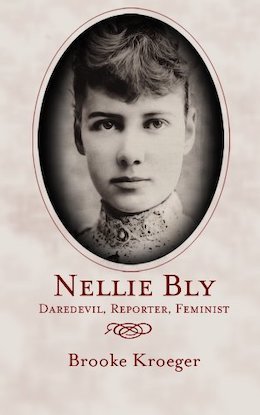
Nellie Bly: Daredevil, Reporter, Feminist by Brooke Kroeger
on Amazon
. . . . . . . . . .
Brooke Kroeger directs NYU Journalism’s graduate Global and Joint Program Studies and has been a faculty member since 1998. She was department chair from 2005-2011 and the Arthur L. Carter Journalism Institute’s inaugural director.
Her latest book, The Suffragents, chronicles the prominent, influential men whose support helped women get the vote. She is also the author of Passing: When People Can’t Be Who They Are, Fannie: The Talent for Success of Writer Fannie Hurst (1999), and others.
. . . . . . . . . .
*This post contains affiliate links. If the product is purchased by linking through, Literary Ladies Guide receives a modest commission, which helps maintain our site and helps it to continue growing!
The post In Search of Nellie Bly: Uncovering America’s Pioneering Investigative Journalist appeared first on Literary Ladies Guide.
January 9, 2019
Nellie Bly: Daredevil, Reporter, Feminist by Brooke Kroeger
From the publisher’s description of Nellie Bly: Daredevil, Reporter, Feminist by Brooke Kroeger, Times Books, 1994: Nellie Bly was “the best reporter in America” according to the New York Evening Journal on the occasion of her death in 1922. One of the most rousing characters of the late nineteenth and early twentieth centuries, Nellie Bly was a pioneer of investigative journalism.
She feigned insanity and got herself committed to a lunatic asylum to expos its horrid conditions. She circled the globe faster than any living or fictional soul. She designed, manufactured, and marketed the first successful steel barrel produced in the United States.
She owned and operated her factories as a model of social welfare for her workers. She was the first woman to report from the eastern front in World War I. She was, in the words of Brooke Kroeger’s captivating biography, the maestra of the front-page sensation story.
Her arrival in New York at the age of twenty-three took New York City by storm. She quickly made a career of self-invention. Her instinct for a scoop was peerless. She thrust herself into the public arena, regaling her avid readers with provocative, even intimate interviews with the great figures of the day.
Her assignments often had the aura of mission, embracing the needs fo the helpless or laying bare the schemes of scam artists and hucksters, from fortune-tellers to powerful lobbyists. She also had an unerring sense of what would sell, and so made a specialty of the jailhouse confessions of accused avengers and murderers.
Soon Bly had imitators in her chosen field of “stunt journalism.” Together, Nellie Bly and her female colleagues were able to bring women — as a class — out of the journalistic sideshow and into the main arena.
. . . . . . . . . . .

Nellie Bly: Daredevil, Reporter, Feminist by Brooke Kroeger on Amazon
. . . . . . . . . . .
Stunts did not appear on the traditional women’s pages. They required daring, resourcefulness, a strong news sense, quick turnaround, and cunning — all qualities Bly possessed in abundance. What set her apart was the force of her personality and the way she wove it without apology or humility into everything she wrote.
Her trademark signature stamped everything she did: compassion and social conscience, buttressed by disarming bluntness. Bly simply produced, week after week, an uninhibited display of her delight in being female and fearless and her joy in having such an attention-getting place as Joseph Pulitzer’s metropolitan daily newspaper to strut her stuff.
Integrating a wealth of previously unknown information with a reporter’s zeal for the hard fact, Brooke Kroeger’s penetrating biography illuminates a pivotal figure in American journalism.
. . . . . . . . . .

. . . . . . . . . .
Nellie Bly: Daredevil, Reporter, Feminist is the first fully documented biography of Bly to give us — in all her complexity — the most famous woman journalist of her day, an extraordinary American industrialist, and a compelling humanitarian.
In tracing the trajectory of Nellie Bly’s life as a woman, critic, and crusader, in describing how Bly did it — how she relentlessly drove herself to surmount challenge after challenge — Kroeger gives us not only an inspiring story but an example of an age when American women were vigorously asserting their right — indeed their need — to shape history itself.
. . . . . . . . . .
Brooke Kroeger directs NYU Journalism’s graduate Global and Joint Program Studies and has been a faculty member since 1998. She was department chair from 2005-2011 and the Arthur L. Carter Journalism Institute’s inaugural director.
Her latest book, The Suffragents, chronicles the prominent, influential men whose support helped women get the vote. She is also the author of Passing: When People Can’t Be Who They Are, Fannie: The Talent for Success of Writer Fannie Hurst (1999), and others.
. . . . . . . . . .
*This post contains affiliate links. If the product is purchased by linking through, Literary Ladies Guide receives a modest commission, which helps maintain our site and helps it to continue growing!
The post Nellie Bly: Daredevil, Reporter, Feminist by Brooke Kroeger appeared first on Literary Ladies Guide.
January 6, 2019
Mary Wollstonecraft’s A Vindication of the Rights of Woman: An Appreciation
In the classic A Vindication of the Rights of Woman by Mary Wollstonecraft argues for equality of men and women: Men and women are both born with equal ability to reason, and therefore power and influence should be available to all regardless of gender. This was a unique and radical view in 1792 when the book was first published.
Considered one of the earliest works of feminist philosophical literature, A Vindication of the Rights of Woman: With Strictures on Political and Moral Subjects was published in 1792.
Mary Wollstonecraft was the mother of Mary Wollstonecraft (Godwin) Shelley, author of Frankenstein. She died just days after giving birth to her namesake, who ended up having an enormous impact on literature and culture in her own right. This modern appreciation is from the preface to Mary Wollstonecraft: A Biography by women’s studies pioneer Eleanor Flexner (Coward, McCann, & Geoghegan, Inc., NY, 1972)
A short and stormy life, a powerful influence
The woman who first effective challenged the age-old image of her sex as lesser and subservient human beings lived a short and stormy life in late 18th-century England. Mary Wollstonecraft was only thirty-eight when she died in 1797.
She wrote a book in which she articulated her protest and her ideas of what education and equality of opportunity might do for society as a whole: A Vindication of the Rights of Woman, published in 1792.
It is not given to many books to exert as powerful an influence as A Vindication has done, although its effect was delayed and for decades it was largely unread. Until the middle of the 19th century, the condition of women remained very much what it had been when Mary Wollstonecraft was goaded into her echoing protest:
Very few were educated, almost no occupations were open to those who needed to earn a livelihood, and women could neither vote nor hold office. Married women did not even exist as a legal entity; they could not enter a legal complaint, appear in court, or retain counsel.
. . . . . . . . . .
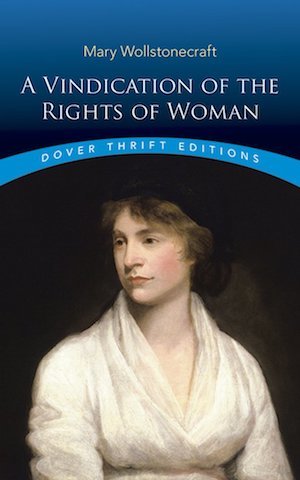
Quotes from A Vindication of the Rights of Woman by Mary Wollstonecraft
. . . . . . . . . .
Wollstonecraft’s singular voice
What is so astonishing about A Vindication is not that Mary wrote it, but that she was alone in raising the issues that she did, in a period of social change first signaled by the rebellion of the American colonies against British rule and then by the tremendous upheaval of the French Revolution.
Hers was the only audible voice raised to assert that women, as well as men, had an inalienable right to freedom, that they too were human beings.
In an age becoming aware of the exploitation of the slave, whose leading minds revolted at the African trade in human bodies, almost no one else echoed her belief in the importance, or even existence, of women as sinking persons.
Mary’s viewpoint was shaped to an unusual degree by the circumstances of her own life and that of other women whom she knew: by their struggles against poverty and debt; by the frustration of minds she herself knew to be capable of achievement but denied their potential development by a society which decreed that women — any woman, all women — lacked the capacity to reason or even think.
At the other end of the social scale she witnessed the corruption brought about by wealth and idleness on women of a different class.
. . . . . . . . . .
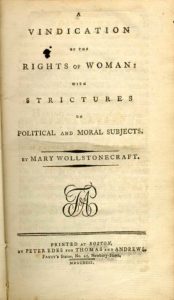
Public domain ebook of A Vindication of the Rights of Woman
. . . . . . . . . .
Written from the perspective of her own circumstances
Her arguments in A Vindication of the Rights of Woman, therefore, are for the most part neither philosophical nor theoretical. Without the circumstances of her own life, Mary Wollstonecraft could not have written the book she did.
If she had been granted the educational opportunities, the leisure and security for study she longed for, she might have been just another bluestocking, as the small number of educated women who became scholars or writers were called by their contemporaries.
But she would not have written incandescent vindication rooted in her own life. The woman who emerged from that life, Mary Wollstonecraft as she really was — by turns reasonable and angry. Beyond all reason; devout and hopeful, then despairing; contemptuous of women, but even more contemptuous of men corrupted by their power over women, wasteful of their opportunities, and irresponsible in the discharge of their obligations — such a woman could not write with gentility or restraint. Instead she wrote a classic.
Because she drew her ideas mostly from her own experience and that of other women she knew, rich and poor, this study of Mary Wollstonecraft has delayed more emphasis on her life dinner on the intellectual trends of the period in which she lived.
. . . . . . . . . .
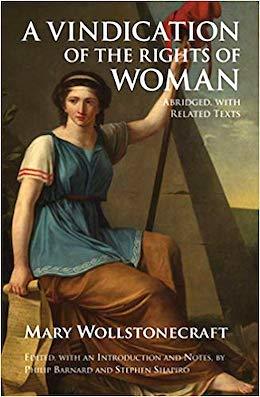
A Vindication of the Rights of Woman on Amazon
. . . . . . . . . .
That complex era — it has been variously called the Enlightenment, the Age of Reason, the Age of Revolution — has been discussed by philosophers, political and social scientists, literary critics, theologians, and historians.
Mary wrote nothing else comparable in significance to A Vindication of the Rights of Woman. She was just turning back to the problems of women in the last year of her life. We can only wonder whether she might have written more books or pamphlets which equals its eloquence and thereby help the movement for equal rights to an earlier start.
This particular woman, alone among her contemporaries, demanded that the rights of man be extended to women and that women be allowed to enter their full human heritage. She died a few days after giving birth, a few months after her 38th birthday. She speaks to us today across a gap of more than two centuries with a voice of courage and hope.
Eleanor Flexner (1908 – 1995) was an independent scholar and helped pioneer the field of Women’s Studies. Her research was concerned with suffrage, abolition social and labor reform, and equal access to education.
. . . . . . . . . .
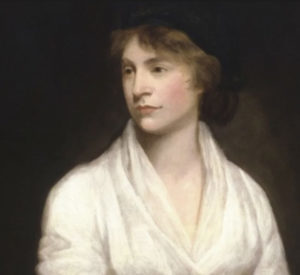
. . . . . . . . . .
“I here throw down my gauntlet, and deny the existence of sexual virtues, not excepting modesty. For many and woman, truth, if I understand the meaning of the word, must be the same … women, I allow, may have different duties to fulfill; but they are human duties, and the principles that should regulate them, I sturdily maintain, must be the same.
To become respectable, the exercise of their understanding is necessary; there is no other foundation for independence of character …”
— Mary Wollstonecraft, A Vindication of the Rights of Woman, 1792
. . . . . . . .
*This post contains affiliate links. If the product is purchased by linking through, Literary Ladies Guide receives a modest commission, which helps maintain our site and helps it to continue growing!
The post Mary Wollstonecraft’s A Vindication of the Rights of Woman: An Appreciation appeared first on Literary Ladies Guide.
January 1, 2019
How Colette Came to Write the Claudine Stories, in Her Own Words
“My name is Claudine, I live in Montigny; I was born there in 1884; I shall probably not die there.” This iconic opening line from Claudine at School (Claudine à l´Ecole ) by French author Colette (1873 – 1954) has become more familiar to English-speaking audiences thanks to the 2018 biopic, Colette.
In 1900, Colette began publishing the series of Claudine stories that defined the teenage girl of the era. In grounbreaking fashion, these books explored the sexual and mischievous side of a young woman coming into her own.
The problem was that her first husband, Willy, whose real name was Henry Gauthier-Villars, long took credit for the books, publishing them under his name.
Claudine at School, the first of the efforts to be published and was an immediate success. More Claudine books followed. When Colette began to rebel at the scheme, Willy locked her in a room until he felt she had produced a sufficient number of pages.
About the Claudine books
From the 1956 Vintage edition, a brief description of the classic series:
“Claudine is a headstrong, clever and extremely mischievous schoolgirl. Along with her friends the gangly Anais, the cheerful Marie and the prim Joubert twins, Claudine wreaks havoc on her small school.
Always clever, witty and charming, Claudine is more than a match for her formidable headmistress as they fight for the attention of the pretty assistant Aimee.
The horrors of examinations and good-humored bullying are the backdrops in this immensely funny and delightful novel with which Colette established the captivating character of Claudine.
Through the games, the fun and the intricacies of school life Claudine emerges as a true original; lyrical and intelligent, she is one of the twentieth century’s most beguiling emancipated women.”
. . . . . . . . . .
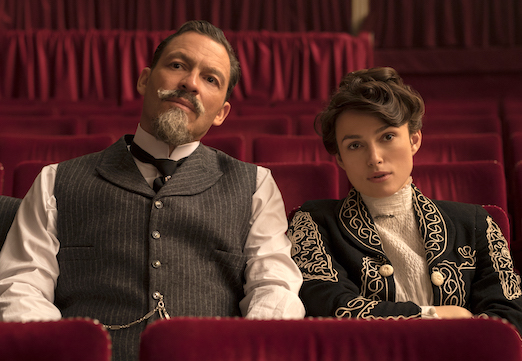
A scene from Colette (2018) starring Kiera Knightly and Dominic West
. . . . . . . . . .
How Colette came to write and reclaim the Claudine books
In the 1956 edition, Colette provides an introduction, told in her unmistakable style, how it came to pass that she began writing the Claudine stories under the thumb of her husband, who she refers to as “Monsieur Willy.” Let’s let Colette take it from here:
I have told in Mes Apprentissages how, some two years after our marriage, therefore about 1895, Monsieur Willy said to me one day:
“You ought to jot down on paper some memories of the Primary School, so I might be able to make something out of them … Don’t be afraid of racy details.”
This curious and still comparatively unknown man, who put his name to I know not how many volumes without having written a single one of them, was constantly on the lookout for new talents for his literary factory.
It was not in the least surprising that he should have extended his investigations as far as his own home.
I was recovering from a long and serious illness which had left my mind and body lazy. But, having found at a stationers some exercise-books like the ones I had at school and bought them again, their cream-laid pages, ruled in grey, with red margins, their black linen spines and their covers bearing a medallion and an ornate title Le Calligraphe gave my fingers back a kind of itch … for the passivity of a set task.
When I had finished, I handed over to my husband a closely-written manuscript which respected the margins. He skimmed through it and said:
“I made a mistake, this can’t be of the slightest use …”
Released, I went back to the sofa, to the cat, to books, to silence, to a life that I tried to make pleasant for myself and that I did not know was unhealthy for me.
The exercise-books remained for two years at the bottom of a drawer. One day Willy decided to tidy top the contents of his desk.
. . . . . . . . . .
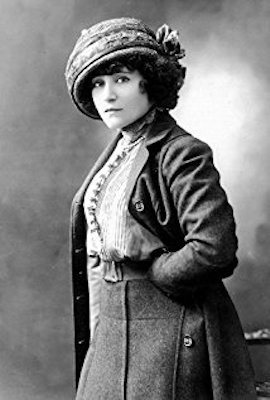
9 Facts About Colette, Prolific and Passionate French Author
. . . . . . . . . .
The appalling counter-like object of sham ebony with a crimson raise top displayed its deal drawers and disgorged bundles of old papers and once again we saw the forgotten exercise-books in which I had scribbled: Claudine à l´Ecole.
“Fancy,” said Monsieur Willy, “I thought I had put them in the waste-paper basket.”
He opened one exercise-book and turned over the pages:
“It’s charming …”
He opened a second exercise-book, and said no more — a third, then a fourth …
“Good Lord,” he muttered, “I’m an utter imbecile …”
He swept up the exercise-books haphazard, pounced on his flat-brimmed hat, and rushed off to a publisher … and that was how I became a writer.
But that was also how I very nearly missed ever becoming a writer. I lacked the literary vocation and it is probably that I should have never produced another line, if, after the success of Claudine à l´Ecole, and other tasks had not, little by little, got me into the habit of writing.
Claudine à l´Ecole appeared in 1900, published by Paul Ollendorf, bearing Willy’s sole name as the author. In the interval, I had to get back to the job again to put a little “spice” into my text.
“Couldn’t you,” Willy said to me, “hot this — these childish reminiscences up a little? For example, a too passionate friendship between Claudine and one of her schoolmates … And then some dialect, lots of dialect words … Some naughty pranks … You see what I mean?”
The pliancy of extreme youth is only equalled by its lack of scruples. What was the extent of Willy’s collaboration? The manuscripts furnish a partial answer to a question that has been asked a hundred times.
. . . . . . . . . .
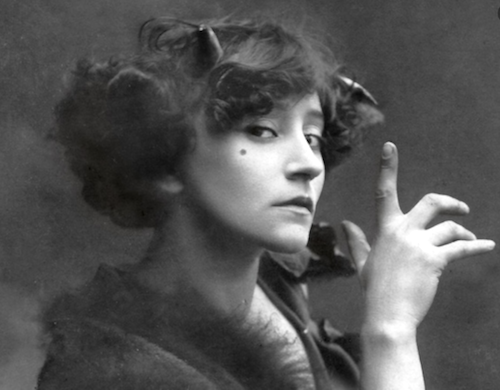
Short and Sweet Quotes by Colette
. . . . . . . . . .
Out of the four Claudine books, only the manuscripts of Claudine en Ménage and Claudine s’en Va have been saved from the destruction which Willy ordered Paul Barlet to carry out.
Paul Barlet, known as Paul Héon — secretary, friend, Negro, and extremely honorable man— suspended the execution, which had begun to be carried out, and brought me what remained, which I still possess.
Turning over the pages of those exercise-books is not without interest. Written entirely in my handwriting, a very fine writing appears at distant intervals, changing a word, adding a pun or a very sharp rebuke …
The success of the Claudine books was for the period very great. It inspired fashions, plays, and beauty products. Being honorable, and above all indifferent, I kept silent about the truth, which did not become known until much later. Nevertheless, it is today … that the Claudine books appear under the single name of their single author.
. . . . . . . . . .
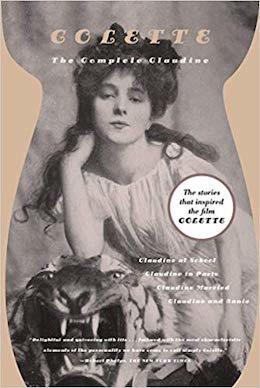
The Complete Claudine on Amazon
. . . . . . . . . .
*This post contains affiliate links. If the product is purchased by linking through, Literary Ladies Guide receives a modest commission, which helps maintain our site and helps it to continue growing!
The post How Colette Came to Write the Claudine Stories, in Her Own Words appeared first on Literary Ladies Guide.
December 29, 2018
Quotes from Mary Poppins and Mary Poppins Comes Back by P.L. Travers
P.L.Travers (1899 – 1996) loved fairy tales and myths from childhood on, and no doubt reading them from childhood on fueled her imagination. Her Mary Poppins series of books have entertained generations of readers, ever since the first volume was published in 1934. As one character in Mary Poppins Opens the Door says of the magical nanny, “She’s a fairy-tale come true.”
Mary Poppins was the basis of the beloved 1964 Disney musical film, which the famously cranky author was none too happy with. What might she have thought of the 2018 film Mary Poppins Returns? It’s doubtful she would have been very pleased with it, either. Her persnickety personality aside, Travers created some of the most memorable characters in children’s literature.
There are eight books in the series in all (see a brief overview of all the Mary Poppins books here), but the first two, Mary Poppins and Mary Poppins Comes Back, are perhaps still the most widely read. Following is a selection of quotes from these timeless children’s classics.
. . . . . . . . . .
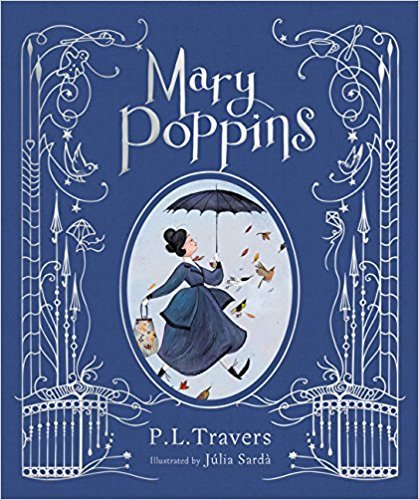
The Literary Magic of the Mary Poppins Series of Books
. . . . . . . . . .
Quotes from Mary Poppins
“There was something strange and extraordinary about her – something that was frightening and at the same time most exciting.”
. . . . . . . . . .
“Mary Poppins was very vain and liked to look her best. Indeed, she was quite sure that she never looked anything else.”
. . . . . . . . . .
“Mary Poppins sighed with pleasure, however, when she saw three of herself, each wearing a blue coat with silver buttons and a blue hat to match. She thought it was such a lovely sight that she wished there had been a dozen of her or even thirty. The more Mary Poppins the better.”
. . . . . . . . . .
“We are all made of the same stuff, remember, we of the Jungle, you of the City. The same substance composes us—the tree overhead, the stone beneath us, the bird, the beast, the star—we are all one, all moving to the same end. Remember that when you no longer remember me, my child.”
. . . . . . . . . .
“Once we have accepted the story we cannot escape the story’s fate.”
. . . . . . . . . .
“You should trust the children; they can stand more than we can.”
. . . . . . . . . .
“I assure you I haven’t been so surprised since Christopher Columbus discovered America — truly I haven’t!”
. . . . . . . . . .
“The same substance composes us–the tree overhead, the stone beneath us, the bird, the beast, the star–we are all one, all moving to the same end.”
. . . . . . . . . .
“And all the time he was enjoying his badness, hugging it to him as though it were a friend, and not caring a bit.”
. . . . . . . . . .
“Oh, go away! You’re in my eyes,” said John in a loud voice.
. . . . . . . . . .
“Sorry!” said the sunlight. “I must move from East to West in a day. Sorry! Shut your eyes and you won’t see me.”
. . . . . . . . . .
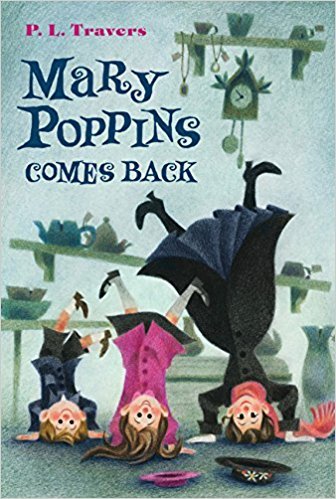
. . . . . . . . . .
Quotes from Mary Poppins Comes Back
“We’re on the brink of an Adventure. Don’t spoil it by asking questions!”
. . . . . . . . . .
“Gently, please, gently! … This is a baby, not a battle-ship!”
. . . . . . . . . .
“I shouldn’t wonder if you didn’t wonder much too much!”
. . . . . . . . . .
As if in a dream, Mary Poppins rocked the cradle—to-and-fro, to-and-fro with a steady swinging movement.
“Yes?” whispered the Fledgling.
“Slowly I moved at first,” said Annabel, “always sleeping and dreaming. I remembered all I had been and I thought of all I shall be. And when I had dreamed my dream I awoke and came swiftly.”
She paused for a moment, her blue eyes full of memories.
“And then?” Prompted the Fledgling.
“I heard the stars singing as I came and I felt warm wings about me. I passed the beasts of the jungle and came through the dark, deep waters. It was a long journey.”
. . . . . . . . . .
“Thank you, ma’am … But I bring the children up in my own way and take advice from nobody,”
. . . . . . . . . .
“Some people … think a great deal too much. Of that I am sure.”
. . . . . . . . . .
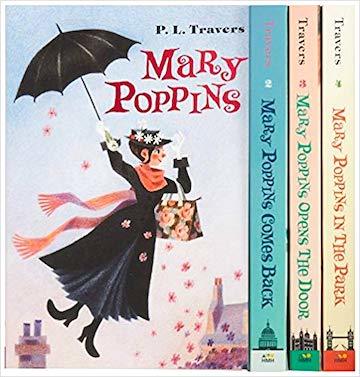
Mary Poppins books and related media on Amazon
. . . . . . . . . .
*This post contains affiliate links. If the product is purchased by linking through, Literary Ladies Guide receives a modest commission, which helps maintain our site and helps it to continue growing!
The post Quotes from Mary Poppins and Mary Poppins Comes Back by P.L. Travers appeared first on Literary Ladies Guide.
December 27, 2018
The Literary Magic of the Mary Poppins Books by P.L.Travers
Mary Poppins, one of the best-loved characters in children’s literature, came from a story that its author, P.L. (Pamela Lyndon) Travers made up while minding two young children.
Mary Poppins, the first book in the series, was published in 1934 to instant success and launched a series starring the magical nanny as the central character. In it, she’s blown to Number 17 Cherry Tree Lane, London by the East wind, and becomes part of the Banks family’s household.
There she takes charge of the children, changing their lives and that of their parents. The books, all illustrated by Mary Shepard, have been a mainstay of classic children’s literature from the time of their publication.
. . . . . . . . . .
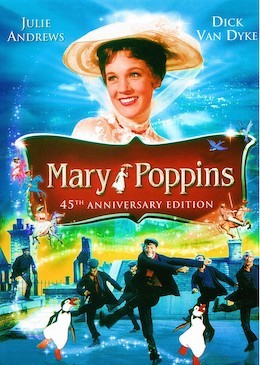
. . . . . . . . . .
If Mary Poppins brings to mind Julie Andrews’ portrayal of her in the 1964 film, you’ll be surprised by how she’s depicted in the books. A darker and more prickly character, here’s how she was described in a Classic of the Month column in the Guardian:
“Mary Poppins is not nice. She arrives, to be the nanny for the four Banks children, riding a puff of wind; she understands, and can be understood by, animals; she can take you round the world in about two minutes; and the medicine she gives you will taste like whatever your heart desires (lime-juice cordial for Jane Banks; milk for the infant Banks twins) — but a spoonful of sugar, to quote the very sugary movie, is nowhere in sight.
. . . . . . . . . .
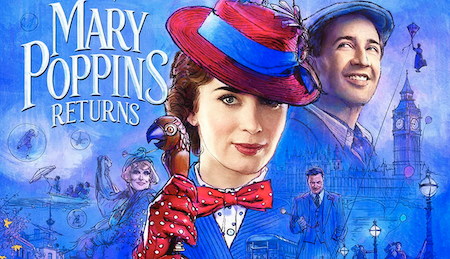
. . . . . . . . . .
2018 saw a cinematic revival with Mary Poppins Returns starring Emily Blunt in the title role and Lin Manuel Miranda in an altered iteration of the role created by Dick Van Dyke in the 1964 Mary Poppins film. The film, released in time for the holiday season, evidently brought more cheer to audiences than to critics. Watch the official trailer.
It goes to show, though, that the magical nanny is still someone we yearn for in these troubled times — “Spit-spot,” as she’s known to say, and our troubles melt away; life becomes less complicated, even as its filled with new and amazing adventures. Who wouldn’t want that?
Here’s a brief description of the books in the main series, as well as a few others that the author added later.
. . . . . . . . . . . .
Mary Poppins (1934)
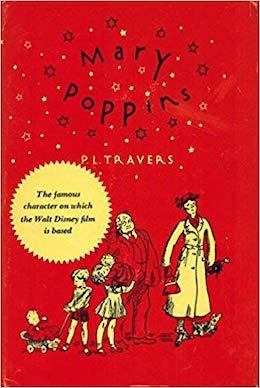
A blast of wind, a house-rattling bang, and Mary Poppins arrives at Number Seventeen Charry-Tree Lane. Quicker than she can close her umbrella, she takes charge of the Banks children — Jane, Michael, and the twins — and changes their lives forever.
Unlike other nannies, Mary Poppins make the most ordinary events extraordinary. She slides up banisters, pulls all manner of wonders out of her empty carpetbag, and banishes fear or sadness with a no-nonsense “Spit-spot.”
Who else can lead the children on one magical adventure after another and still gently tuck them in a the end of the day? No one other than the beloved nanny Mary Poppins. (from the 1981 Harcourt, Brace edition)
. . . . . . . . . . . .
Mary Poppins Comes Back (1935)
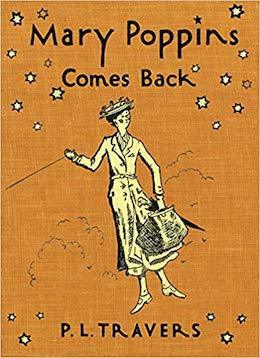
When she left the Banks family in that highly unconventional but characteristic manner, sailing over the housetops in the wake of her umbrella, it was well understood that Mary Poppins would come back one fine day.
And sure enough, here she is, ready to take the Banks children through a new series of adventures, more completely captivating than before. In these delectable pages you learn — or do you? — the secret of her return. You meet the King of the Castle and the Dirty Rascal …
And there’s Mr. Turvy’s Second Monday and Jane’s Bad Wednesday, and many expeditions into Mary Poppins’ own special fairyland. Turn to the first page and start such an adventure as you will find nowhere outside of Cherry Tree Lane. (from the 1963 Harcourt, Brace edition)
. . . . . . . . . . . .
Mary Poppins Opens the Door (1943)
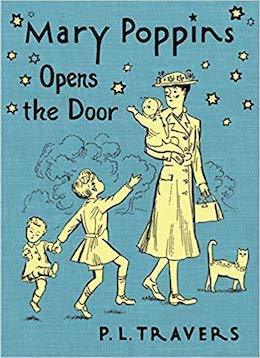
From the moment Mary Poppins arrives at Number Seventeen Cherry-Tree Lane, everyday life at the Banks house is forever changed. This classic series tells the story of the world’s most beloved nanny, who brings enchantment and excitement with her everywhere she goes. Featuring the charming original cover art by Mary Shepard, these new editions are sure to delight readers of all ages.
Mary Poppins reappears just in time! According to her tape measure, Jane and Michael have grown “Worse and Worse” since she went away. But the children won’t have time to be naughty with all that Mary has planned for them.
A visit to Mr. Twigley’s music box-filled attic, an encounter with the Marble Boy, and a ride on Miss Calico’s enchanted candy canes are all part of an average day out with everyone’s favorite nanny. (from amazon.com)
. . . . . . . . . .
Mary Poppins in the Park (1952)
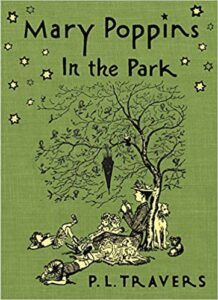
Who else but Mary Poppins can lead the Banks children — Jane, Michael, and the twins — on such extraordinary adventures? Together they all meet the Goosegirl and the Swineherd, argue with talking cats on a distant planet, make the acquaintance of folks who live under the dandelions, and celebrate a birthday by dancing with their own shadows. And that just for starters!
The fourth and final book in this beloved series features six whimsical tales that occurred during the magical nanny’s three previous visits. “She cannot forever arrive and depart,” P.L. Travers explains — though after joining Mary Poppins for these six adventures, who can blame a reader for wanting her to come back again and again! (from the 1980 Harcourt, Brace edition)
. . . . . . . . . .
Mary Poppins from A to Z (1962)
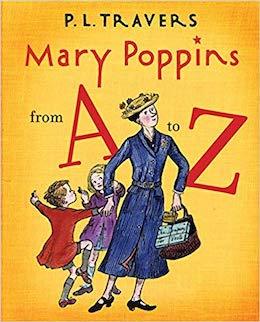
Mary Poppins is back again! With Incomparable wit, P.L. Travers has written twenty-six short episodes, one for each letter of the alphabet, about Mary Poppins and all the characters of the earlier books …
For all who know and love Mary Poppins, and for smear children who still have that joy to come, this wonderful, funny, crisp, tongue-twisting text … will be an irresistible, never-to-be-forgotten experience. (from the 1962 edition, John Lyndon, Ltd. edition)
. . . . . . . . . .
Mary Poppins in the Kitchen (1975)
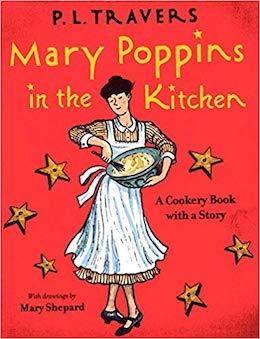
Subtitled A Cookery Book with a Story, this entry offers a unique glimpse at the famous Poppins cast as the spit-spot English nanny and the Banks children take over the kitchen for a week.
With the help of familiar visitors like the Bird Woman, Admiral Boom, and Mr. and Mrs. Turvy, Mary Poppins teaches her irrepressible young charges the basics of cooking, from A to Z. And young readers can re-create the week’s menus by following the thirty different recipes. Kitchen adventures were never so much fun! (from amazon.com)
. . . . . . . . . .
Mary Poppins in Cherry Tree Lane (1982)
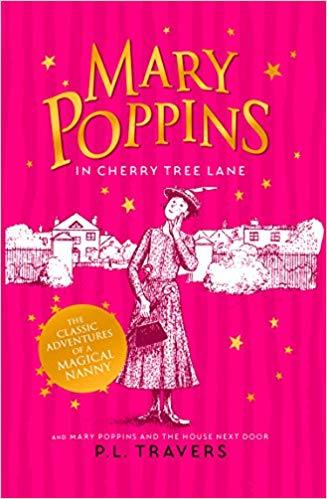
She’s back! From where, we do not know and are not likely to be told, for it is one of Mary Poppins’ chief characteristics that she never explains. However, her she comes once again pushing the perambulator, the familiar upright figure with bright pink cheeks, bright blue eyes, and turned-up nose, taking the Banks children on yet another memorable adventure.
It’s now the most special of nights, Midsummer’s Eve. All kinds of strange things can happened, and even mythical figures can descend from the heavens. But Mary Poppins takes all in stride, managing to draw everyone, including the trembling Park Keeper, into the spirit of this romantic, magical holiday. (from the 1982 Delacorte Press edition)
. . . . . . . . . .
Mary Poppins and the House Next Door (1988)
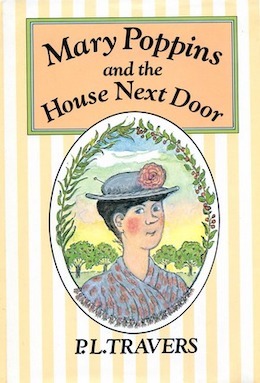
Mary Poppins, the unflappable nanny of the Banks children, is back again! It is a day like any other for Mary Poppins and the Banks family in Number Seventeen Cherry Tree Lane – until a telegram arrives with the momentous news that Miss Andrews, the Holy Terror, is coming to live in the house next door.
The house has always been empty and so has become the treasure of Cherry Tree Lane – each neighbor has filled it with personal dreams. But now peace in the lane is gravely threatened. Can Mary Poppins, in her own magical, whimsical way, resolve the crisis? (from amazon.com)
. . . . . . . . . .

Mary Poppins books and related media on Amazon
. . . . . . . . . .
*This post contains affiliate links. If the product is purchased by linking through, Literary Ladies Guide receives a modest commission, which helps maintain our site and helps it to continue growing!
The post The Literary Magic of the Mary Poppins Books by P.L.Travers appeared first on Literary Ladies Guide.
December 25, 2018
Flannery O’Connor
Flannery O’Connor (March 25, 1925 – August 3, 1964) was born Mary Flannery O’Connor in Savannah, Georgia. She became best known for her short stories, morally driven narratives populated with flawed characters sometimes described as grotesque.
O’Connor was viewed as a bit different by her fellow townspeople in Milledgeville, Georgia. She stood somewhat apart from the itinerant farm workers and country folk, becoming something of an observer. There was nothing she wanted to do other than write.
You may notice that some of her book covers feature peacocks; that’s a nod to her raising of the beautiful birds in her youth on her family’s farm.
First novel and a diagnosis
After graduating from a woman’s college in Milledgeville, O’Connor attended the prestigious writing program at the University of Iowa.
During a fellowship at Yaddo in 1948, the prestigious residency in Saratoga Springs, she worked on the stories that would later make their way into A Good Man is Hard to Find (1955). The following year, 1949, she moved to New York City . At the age of 24, she was ready to begin her writing career in earnest.
While working on her first novel, Wise Blood, O’Connor was diagnosed with lupus, the rare autoimmune disorder from which her father had died. Soon after, she moved back to Milledgeville. There she stayed, living with her mother for the rest of her life. She helped her mother raise chickens and peacocks as she pursued her writing.
“I am going to be the World Authority on Peafowl, and hope to be offered a chair some day at the Chicken College,” she wrote with her characteristic dry wit to writer Robert Lowell.
For a time, costly steroid medications helped control her symptoms. Even while stricken with lupus, she wrote every day, producing a body of work that included two novels and more than thirty short stories.
. . . . . . . . .
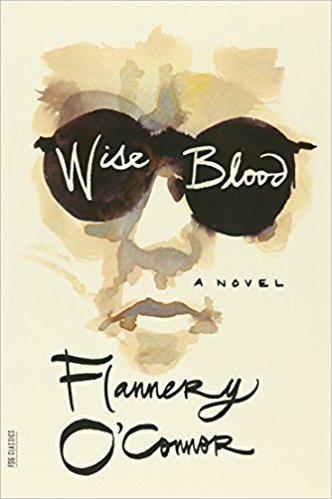
Flannery O’Connor on the Grotesque in Fiction
. . . . . . . . .
Southern Gothic, the grotesque, and the role of religion
Today, her work is still much discussed because of its detail, symbolism and imagery. Her work is categorized as Southern Gothic and relies heavily on regional themes. In this way, it bears a stylistic relationship to the writings of Carson McCullers and William Faulkner. As noted in Women of Words by Janet Bukovinsky Teacher (1992):
“These writers took their inspiration from the regional mysteries and peculiarities of the deep South — its characters, language, and ways of life.
Before a reading of her work, O’Connor once said, ‘I doubt if the texture of Southern life is any more grotesque than that of the rest of the nation, but it does seem evident that that the Southern writer is particularly adept at recognizing the grotesque.’
O’Connor said: “Whenever I’m asked why Southern writers particularly have a penchant for writing about freaks, I say it is because we are still able to recognize one. To be able to recognize a freak, you have to have some conception of the whole man, and in the South the general conception of man is still, in the main, theological.”
O’Connor also famously said: “Anything that comes out of the South is going to be called grotesque by the northern reader, unless it is grotesque, in which case it is going to be called realistic.” Though her themes were often serious and dark, her writing was imbued with wit.
O’Connor was Catholic, which set her apart in a region filled with Baptists and Protestants. Her faith imbued her work with a personal and sometimes peculiar vision. Wise Blood tells of a violent young religious extremist. Fanaticism is also at the heart of The Violent Bear it Away.
. . . . . . . . . . .
Flannery O’Connor on the Grotesque in Fiction
. . . . . . . . . .
The art and craft of the writing life
O’Connor kept her private life to herself, but was outspoken on the art and craft of writing and the writing life. Some have said that a seething anger rises up from her stories. Wise Blood, The Violent Bear it Away, and her collection of stories, A Good Man is Hard to Find, were all praised by critics.
Although she lived a somewhat sheltered life, O’Connor’s work depicted subtleties of human behavior with razor precision. Her dark humor wasn’t appreciated by all — its religious overtones (she was a devout Catholic) were highly provocative. She was also an avid book reviewer, penning more than one hundred reviews for various publications.
Writing was almost a redemptive act. She said in Mystery and Manners: Occasional Prose (1970):
“I have found, in short, from reading my own writing, that my subject in fiction is the action of grace in territory largely held by the devil. I have also found that what I write is read by an audience which puts little stock either in grace or the devil. You discover your audience at the same time and in the same way that you discover your subject, but it is an added blow.”
O’Connor was asked why she wrote, and her answer was “Because I’m good at it.” It wasn’t a statement of ego, but one of fact. She was deeply immersed in the craft, writing and rewriting.
. . . . . . . . . .
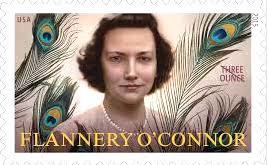
Flannery O’Connor Quotes on Writing and Literature
. . . . . . . . . .
Later Life
Despite her illness — and the treatment for it, which also weakened her — O’Connor enjoyed traveling and giving talks, and continued to write. In 1964, she had surgery for a stomach disease, which exacerbated the lupus. She died on August 3 of that year. She was 39 years old.
In 1971, the posthumous Collected Stories won the National Book Award. One critic noted that she “did not live long, but she lived deeply, and wrote passionately.
. . . . . . . . . .
Flannery O’Connor page on Amazon
More about Flannery O’Connor on this site
“A Good Man is Hard to Find” — an analysis
O’Connor on the Grotesque in Fiction
Wise Quotes by Flannery O’Connor
Flannery O’Connor quotes on writing and literature
Dear Literary Ladies: How can I develop good writing habits?
Dear Literary Ladies: Should I take time off work to write full time?
Dear Literary Ladies: How much do authors want their work to be analyzed?
Major works
A Good Man is Hard to Find and Other Stories
Everything that Rises Must Converge
Wise Blood
The Violent Bear It Away
Autobiographies and Biographies about Flannery O’Connor
The Habit of Being: Letters of Flannery O’Connor
Flannery: A Life of Flannery O’Connor by Brad Gooch
Flannery O’Connor: A Life by Jean W. Cash
More Information
Wikipedia
Reader discussion of Flannery O’Connor’s books on Goodreads
. . . . . . . . . .
*This post contains affiliate links. If the product is purchased by linking through, Literary Ladies Guide receives a modest commission, which helps maintain our site and helps it to continue growing!
The post Flannery O’Connor appeared first on Literary Ladies Guide.

